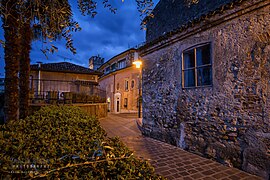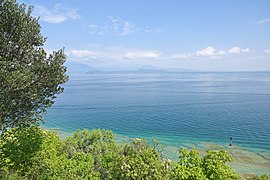
Lake Garda is the largest lake in Italy. It is a popular holiday location in northern Italy, between Brescia and Milan to the west, and Verona and Venice to the east. The lake cuts into the edge of the Italian Alps, particularly the Alpine sub-ranges of the Garda Mountains and the Brenta Group. Glaciers formed this alpine region at the end of the last ice age. The lake and its shoreline are divided between the provinces of Brescia, Verona (south-east) and Trentino (north).

Salò is a town and comune in the Province of Brescia in the region of Lombardy on the banks of Lake Garda, on which it has the longest promenade. The city was the seat of government of the Italian Social Republic from 1943 to 1945, a state often referred to as the "Salò Republic".

Desenzano del Garda is a town and comune in the province of Brescia, in Lombardy, Italy, on the southwestern shore of Lake Garda. It borders the communes of Castiglione delle Stiviere, Lonato, Padenghe sul Garda, and Sirmione.

The province of Brescia is a province in the Lombardy region of Italy. It has a population of some 1,265,964 and its capital is the city of Brescia.

Lonato del Garda is a town and municipality in the province of Brescia, in Lombardy, northern Italy. Lonato is located about halfway between Milan and Venice, on the southwest shore of Lake Garda, the biggest lake in Italy.

Manerba del Garda is a town and comune in the province of Brescia, in Lombardy. It is located at the southwest side of the Lake Garda.

Padenghe sul Garda is a town and comune in the province of Brescia, in Lombardy. It is situated on the southwest coast of Lake Garda. Neighbouring communes are Calvagese della Riviera, Desenzano del Garda, Lonato del Garda, Moniga del Garda and Soiano del Lago.
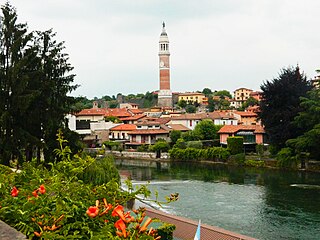
Palazzolo sull'Oglio is a city and comune in the Province of Brescia, in the region of Lombardy in northern Italy. It is located south of Lake Iseo, bordering the Province of Bergamo, and has a population of 20,208. It is the fifth largest city in the Province, after Brescia, Desenzano del Garda, Montichiari and Lumezzane.
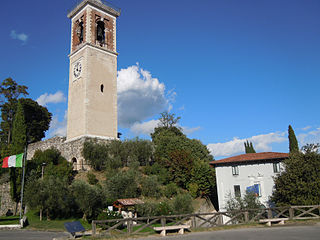
Puegnago del Garda is a comune in the province of Brescia, in Lombardy.

Peschiera del Garda is a town and comune in the province of Verona, in Veneto, Italy. When Lombardy-Venetia was under Austrian rule, Peschiera was the northwest anchor of the four fortified towns constituting the Quadrilatero. The fortress is on an island in the river Mincio at its outlet from Lake Garda.

Albino is a comune in the province of Bergamo, in Lombardy, northern Italy. It is located northeast of Bergamo and is situated in the valley of the river Serio. The comune is included in the perimeter of the Alpine Convention international treaty.
Sirmio is a promontory at the southern end of Lake Garda, projecting 3.3 kilometers (2.1 mi) into the lake. It is celebrated in connection with the Roman poet Catullus, as the large ruins of a Roman villa known as the Grottoes of Catullus on the promontory have been supposed to be his country house. Catullus, upon his return home from a long voyage, joyously describes Sirmio as Paene insularum, Sirmio, insularumque ocelle in his Carmen XXXI, Ad Sirmionem insulam. A post station bearing the name Sirmio stood on the highroad between Brixia and Verona, near the southern shore of the lake. On the shore below is the village of Sirmione, with sulfur baths.
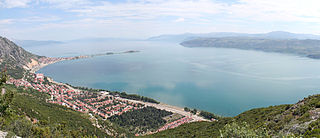
Eğirdir is a town in Isparta Province in the Mediterranean Region of Turkey. It is the seat of Eğirdir District. Its population is 16,759 (2022).

Bardolino is a comune (municipality) in the Province of Verona in the Italian region Veneto, located about 130 kilometres (81 mi) west of Venice and about 25 kilometres (16 mi) northwest of Verona.

Lazise is a comune (municipality) and town in the Province of Verona in the Italian region Veneto, located about 120 kilometres west of Venice and about 20 kilometres northwest of Verona. It is situated on the eastern shore of Lake Garda. As of 31 December 2004, it had a population of 6,213 and an area of 65.0 square kilometres (25.1 sq mi). This geographical location empowers a position of great landscape value, but it also features elements of architectural value and of historical importance.

Valeggio sul Mincio is a commune in the Province of Verona, region of Veneto, Italy, located about 120 kilometres (75 mi) west of Venice and about 25 kilometres (16 mi) southwest of Verona. It is crossed by the Mincio river. Its frazione of Borghetto is one of I Borghi più belli d'Italia.

Desenzano del Garda-Sirmione station is a railway station serving the town and comune of Desenzano del Garda, in the region of Lombardy, northern Italy. Opened in 1854, it forms part of the Milan–Venice railway.

Grottoes of Catullus is the name given to the ruins of a Roman villa built between the end of the 1st century BC and the beginning of the 1st century AD at the northernmost end of the Sirmione peninsula on the southern shore of Lake Garda.

The Scaligero Castle is a fortress from the Scaliger era, access point to the historical center of Sirmione, on Lake Garda. It's one of Italy's best preserved castles. In 2019 it was the 22nd most visited attraction in Italy, with 308,459 visitors.

The Rocca di Manerba del Garda is a rocky promontory, that extends along the southwestern coast of Lake Garda, in Lombardy, Italy. The site, named after its medieval fortification period, is archaeologically significant, with human occupation evidenced from the Mesolithic, Neolithic, Bronze Age, Iron Age, ancient Roman and Medieval periods. Archaeological features include the ruins of the medieval fortification on the summit, and, on the south-western side of the peninsula, the remains of an ancient Roman villa. It consists of two main peaks: the Rocca Vecchia and the hill with the hermitage of San Giorgio.








